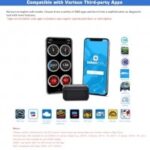It’s a common misconception that connecting your car’s analog sensors directly to an Arduino, and then to an OBD2 app like RealDash, will magically display your car’s data. Many enthusiasts starting their DIY car modification journey believe it’s a straightforward plug-and-play process. However, the reality is more complex and requires a deeper understanding of signal processing and data translation. Simply wiring up your Arduino to the wires that were previously connected to your car’s original panel and expecting immediate results with your OBD2 app will likely lead to disappointment.
The crucial point to understand is that the signals from your car’s sensors – whether it’s the RPM sensor, speed sensor, fuel level sensor, or any other analog sensor – are not inherently in a format that Arduino or OBD2 apps can readily interpret. The type of signal each sensor delivers is unique, and therefore, different interface electronics are necessary to make the Arduino “understand” these signals.
Think of it like this: your car’s sensors are speaking different languages. Your RPM sensor might be “speaking Spanish,” your speed sensor “Italian,” and your fuel level sensor “Arabic.” Arduino, in this analogy, speaks English. RealDash, while also “speaking English,” might have its own specific “dialect.”
The naive approach assumes a direct English-to-English communication:
RPM Sensor (English) --> Arduino (English) --> RealDash (English)But the actual situation is far more nuanced and requires translation:
RPM Sensor (Spanish) --> Translator --> Arduino (English) --> RealDash (English Dialect) --> RealDash
Speed Sensor (Italian) --> Translator --> Arduino (English) --> RealDash (English Dialect) --> RealDash
Tank Level Sensor (Arabic) --> Translator --> Arduino (English) --> RealDash (English Dialect) --> RealDashAnd to make matters even more challenging, you often don’t even know what “language” your sensors are speaking! You haven’t specified the type of signals your RPM, speed, or tank level wires are carrying. This is akin to trying to translate from an unknown language without knowing if it’s Spanish, Italian, Arabic, or something else entirely.
RPM Sensor (Unknown Language) --> Unknown Translator --> Arduino (English) --> RealDash (English Dialect) --> RealDash
Speed Sensor (Unknown Language) --> Unknown Translator --> Arduino (English) --> RealDash (English Dialect) --> RealDash
Tank Level Sensor (Unknown Language) --> Unknown Translator --> Arduino (English) --> RealDash (English Dialect) --> RealDashTherefore, successfully connecting analog signals to your OBD2 app via Arduino requires a customized approach. You’ll need to identify the type of analog signals your car’s sensors are outputting. This might involve voltage signals, current signals, or frequency signals, among others. Once you understand the signal type, you can design or select the appropriate interface electronics – the “translator” – to condition these signals into a format that the Arduino can read. This might involve signal conditioning circuits, voltage dividers, op-amps, or specialized analog-to-digital converters (ADCs), depending on the specific sensor and signal characteristics.
After the signal conditioning, the next crucial step is writing custom Arduino code. This code acts as the core translator, reading the processed analog signals from the interface electronics and converting them into digital data that can be interpreted by RealDash or other OBD2 apps. This code will perform any necessary conversions, scaling, and formatting to ensure the data is accurately represented and displayed in your chosen application. The Arduino code is the key to bridging the gap between your car’s analog world and the digital OBD2 environment.
In conclusion, interfacing analog car signals with OBD2 apps is not a simple matter of direct connection. It necessitates a thorough understanding of analog signals, appropriate interface electronics for signal conditioning, and custom-written Arduino code for signal interpretation and data formatting. By approaching this task with a clear understanding of these requirements, you can successfully unlock the wealth of data from your car’s analog sensors and display it in your favorite OBD2 application, creating a truly customized and informative digital dashboard experience.
